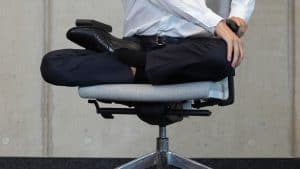We don’t pay attention to the amount of time we spend sitting, but we spend a good portion of our days on a chair, especially while working in front of a computer. As we focus on our work, trying to get through the day, we forget about our bodies until we’re in physical pain or our legs go numb. If this sounds all too familiar to you, we’ve got you covered.
Many people suffer from chronic back pain and posture problems due to prolonged sitting. It’s a common problem among office workers, but it affects anyone who sits for long periods of time. Learning how to properly sit at a computer and adjusting a few things in your work environment can help you avoid these issues.
Today, we’ll share tips on how to sit at a computer desk, explain how to sit ergonomically at a desk, and discuss chair ergonomics.

How to Sit Properly at a Computer
Sitting properly is not just about sitting up straight. It’s about maintaining a position that suits and supports the natural shape of your spine. To maintain this natural shape, curved body parts like the neck and the lumbar (lower back) region must be supported. Additionally, having elbow supports and a footrest can help you keep a healthy sitting position even more effortlessly.
To sit properly at a computer, you first need to adjust the height of your chair to your ideal height. Many of us don’t realize it, but having your chair too low or too high while sitting at a computer can cause chronic pain and posture problems in the long run.
To set your chair at the perfect height for your desk and your computer screen, you can simply follow these steps:
- Sit in an upright, natural position without extending your hips or neck too much,
- Keep your knees bent at a right angle (90 degrees),
- Keep your feet parallel to the floor, and
- Adjust the height until your feet touch the ground firmly.
Make sure to follow these steps accurately, and you’ll notice the difference in a short while. If you accidentally set the chair too low, you’ll know because you’ll probably want to tuck one of your legs under or sit cross-legged. Despite their comfiness, these positions are not ideal, and they might cause lower back pain.
Much like setting your chair too low, setting it too high can cause pain in your knees and hips. A good way to know if your chair is too high is to check if your feet are dangling off the chair. If this is the case, make sure to lower the chair to an appropriate height.
If you want to find out more about making your chair comfortable, check out our post on how to make your chair more comfortable.
Now that we explained how to set your chair height, let’s look at some other important things you should look out for.
How to Sit in an Ergonomic Chair
Most people think an ergonomic chair is just a well-designed seat with orthopedic support. However, there’s a lot more that goes into the ergonomics of a chair than just a lumbar or neck support feature. Even the armrests of your office chair contribute to your overall well-being. Here’s everything you need to know to adjust your chair’s settings so that you are comfortable.
Height Adjustability
As we mentioned above, chair height is essential for maintaining good posture. That’s why you need a good chair with a good height adjustability feature.
Height adjustable chairs utilize a gas lift or a hydraulic lift mechanism. Although these mechanisms work in similar ways, the quality of the materials used can still make or break a chair. Looking for a chair that’s built with quality materials can ensure that your height adjustment lever stays functional for a long time.
Additionally, the height range of a chair is another point to consider. As we said, it’s important to keep your chair at the correct height, and you want a chair that can go as high or low as you need.
If you’re not happy with your chair’s height adjustment setting but don’t want to splurge on a new chair, you can check out our post on how to raise an office chair, where we share some lifesaving tips.
Lumbar and Neck Support
You’re probably aware of this by now, but you need every bit of support you can get to maintain a good posture. This is why lumbar and neck support features are a must if you’re looking for an ergonomic chair.
The lumbar region is the inward curve in our lower backs, and it’s crucial to give this region extra support. Lumbar support helps keep your spine in a neutral position and allows you to sit upright.
Most office chairs have a lumbar support adjustment knob that controls an inner mechanism. On gaming chairs, on the other hand, lumbar support is usually provided through a detachable pillow that has straps for adjustment. If this is the case, going for a chair that has a larger pillow is a good idea. Most gaming chairs on the market only offer a small pillow that doesn’t provide enough support.
The neck support is another feature that can save you a lot of pain in the long run, but it’s not as commonly found as lumbar support. Most office chairs provide neck support through a detachable headrest, but some may not feature a headrest at all.
It’s not uncommon for office chairs to have low backrests. You can’t attach a headrest to these chairs so they’re not very ergonomic. On the other hand, most gaming chairs have high backrests. These chairs usually provide neck support similar to the way they provide lumbar support, with a detachable pillow, and they work very well.
A chair with good lumbar and back support, like the Duramont Ergonomic Chair, can help you sit comfortably at your desk for long hours.
The Recline Function
This might come as a surprise, but sitting “upright” in the literal sense may not be the best for you if you’re working long hours. In reality, the best position to sit is leaning 10-30 degrees past a 90-degree. Therefore the reclining functionality is quite important.
According to Cornell University’s Ergonomics Department, the ideal angle you should set your recliner is around 100-110 degrees. Therefore, a chair that doesn’t offer a recline setting is a no-go if you’re worried about your posture and spinal health.
Unfortunately, the recline function breaks down very often. Again, looking for a quality chair is key here. Some low-quality office chairs have a recline setting, but the mechanism may feel flimsy. They will eventually break if the material is not strong enough to carry your weight. If you’re getting a new chair, try it out first, and see if the mechanism causes any creaking or noise.
Armrests
In addition to the lumbar and neck support, giving your body proper support through your arms can do wonders for your posture.
Armrests ensure that your body is never without support. If you position them correctly, your arms can take some of the stress off your hips and shoulders. For extra comfort, you can choose a chair that has padded armrests. Some armrests even feature memory foam padding, a very comfortable material that takes the shape of your body, but it doesn’t sink and can return to its original shape.
If your chair features hard, flat armrests, on the other hand, you can easily find padded armrest covers or replacements online. Installing these is very simple and requires little to no effort.
If you’re living in a hot area, even the thought of padded armrests might be enough to make you sweat, but there is a solution for that as well. There are padded armrests that have Memory Foam Armrest Pads - Office Chair armrest Pads... to prevent sweating, and you can usually get a pair for a low price.
We should also add that armrest adjustability is another feature that can set a chair apart. While some chairs offer no adjustability, some models may allow you to adjust the height. This is an important feature since resting your arms at a 90-degree angle is important for your spinal health.
If you want to learn about chair ergonomics in more detail, you can head over to our post, where we answer the question “What is an ergonomic chair?”.
How to Ergonomically Sit at a Desk
Things such as your monitor placement and your sitting habits also play a huge role in sitting properly. Let’s briefly take a look at these before we conclude our post.
Adjust Your Monitor Height
Even if you set the height of your chair correctly and adjusted all features accordingly, you’re only halfway there in terms of sitting ergonomics. If you have to look up to see your monitor after configuring your chair settings, other issues might be on the horizon for you.
Ideally, your monitor should be placed so that your eyes meet the upper third of the screen when you look at the monitor directly.
Since your computer is what you’ll be looking at most of the time, a monitor that’s placed too high will cause you to look up all the time. This is not an ideal position and may cause chronic neck pain in the long run.
Similarly, having your monitor placed too low can become a problem, as constantly looking down will put too much strain on your neck and shoulders. This may also cause a “tech neck,” which is a funny term with not-so-funny implications. In the simplest terms possible, a tech neck is caused by constantly looking down at our phones, tablets, and computers. This condition may cause chronic pain, spasms, and disfiguration of the spine in severe cases.
Alternate Between Sitting and Standing
You see, even with the best desk and chair configuration, constant sitting is ultimately harmful to your body. Studies have found that office workers who sit regularly face a variety of problems related to their orthopedic health, as well as being more susceptible to cardiovascular diseases and diabetes.
As the adverse effects of prolonged sitting are becoming more apparent, we should reconsider our working habits.
Standing desks have been gaining popularity in recent years.
A standing desk is a desk you can use while standing up. These desks usually come with height adjustment functionality and can be used as a regular-height desk. They can feature a button that changes the height electronically or a crank to adjust the height manually. Standing desks are usually accompanied by a standing chair which allows you to rest every once in a while.
Since it’s recommended to alternate between sitting and standing, having a standing desk chair is crucial if you’re planning on working at a standing desk. These chairs can help you strike a healthy balance between sitting and standing, and some even offer a leaning option.
It’s a great solution that’s worth giving a shot if you have chronic back pain. Luckily, we have reviewed some of the best options on the market in our post on the best standing desk chairs.
Conclusion
As you see, ergonomics is not just about the comfiness of your chair but also about how you position your body.
First and foremost, your chair height should be set at the right height for your body. Additionally, an ergonomic chair should feature lumbar and neck support and robust armrests to support your spine. Since sitting upright means sitting at a slightly reclined angle, your chair’s recline function is also essential.
Setting your computer at the correct height is also very important. If you’re looking for a long-term solution., getting a standing desk and alternating between sitting and standing is the best idea. . We recently reviewed an excellent standing desk that might fit your needs.
